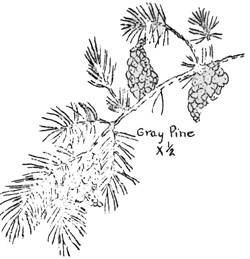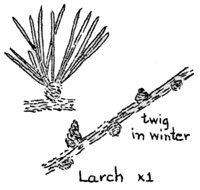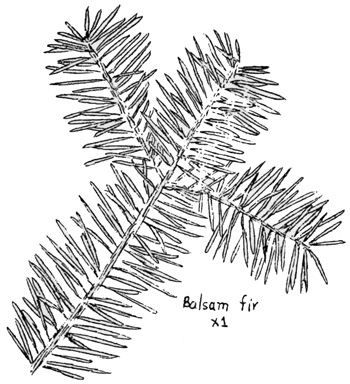

|
|
NATURE NOTES FROM ACADIA
By Arthur Stupka, Park Naturalist, Acadia National Park The trees of Acadia National Park, Mount Desert Island, Maine, are essentially northern in character, as the region belongs to the so-called Spruce and Northern Hardwoods division. Spruces are dominant, the red spruce making up a considerable portion of the coniferous stand over much of the island and the white spruce replacing it as the most abundant species along a large portion of the ocean front. Other trees which make up an appreciable amount of the total stand include white pine, red pine, white birch, gray birch, arbor vitae, balsam fir, red maple, red oak, hemlock, and aspen. Thoreau, with characteristic fitting and poetic phraseology, called this the "arrowy Maine forest." SECTION I. THE CONIFERS Key to the Conifers of Acadia National Park

Four species of pines are native to the region and of these the white pine (Pinus strobus), emblem of Maine, the Pine Tree State, is most abundant. This, the noblest of our trees, has been known to exceed 4 feet in diameter and 150 feet in height, and has long been regarded as the most valuable timber tree in northeastern America. Its soft bluish-green needles are arranged in clusters of 5, the lateral branches are whorled, and the cones, usually measuring from 5 to 8 inches in length, are larger than those of any other native coniferous tree in the northeastern states. The red pine Pinus resinosa, whose needles 4 to 6 inches in length, are longer than those of any other of our needle-bearing trees, is tall and straight, with a pyramidal crown, dark green foliage, and reddish-brown bark. This bark, like the bark of the yellow pine of the west, tends to break up into broad reddish plates. The needles are arranged in bundles of 2. The symmetrical cones are somewhat spherical and about 2 inches long. It is valued highly as a timber tree and often goes by the name of "Norway pine." 
The pitch pine (Pinus rigida), very picturesque in its exposed rocky habitats, is usually low-growing and has an irregular scraggly crown. Its ovate cones may persist on the gnarled branches for many years. This is the only native pine of Mount Desert Island whose needles are arranged in clusters of 3. A boreal species, the gray, jack, or Labrador pine (Pinus banksiana), finds its southern coastal limit on Mount Desert Island. It is rare here, being represented by a small stand of trees to the south of Cadillac Mountain. On a portion of the Acadia National Park area which is located just across the by on Schoodic Peninsula, this pine is an abundant species. For the most part it grows considerably dwarfed and shrubby, and its small, tough, asymmetrical cones persist on the tree for many years. Its very short gray-green needles are arranged in clusters of 2.

The larch, also known as tamarack and hackmatack (Larix laricina), is a common tree of the sphagnum bogs of the island. Unlike all other of our coniferous species, it sheds all its needles every fall, putting on new ones the following spring. These needles are borne on dwarf spur-like side branches. As it resembles a symmetrical pine in general form, the tree has a striking resemblance to a dead conifer in winter. It is a medium-sized, light-loving tree with a straight trunk, very small ovoid cones, and short clustered needles. The range of the larch extends across the continent, and it is found in the north within the Arctic Circle. Three spruces are native to Acadia National Park. The black
spruce, also known as swamp spruce (Picea mariana), is a tree
characteristic of our sphagnum bogs, although it is not infrequently
found in a more or less stunted condition on dry mountain slopes where
Although in cool moist ravines the hemlock (Tsuga canadensis)
grows as far south as Alabama, it attains its greatest size and beauty
in the Acadian region. In its preferred habitat it is a fairly common
tree on Mount Desert Island where old specimens up to four feet in
diameter are to be found. Its short flat needles are glossy dark green
The balsam fir (Abies balsamea), the only fir native to Maine
and the other New England states, is a common conifer in Acadia National
Park. It is a tree of medium size, usually under 40 feet in height, and
the trunk rarely exceeds 18 inches in diameter. Its bark, smooth and
grayish-brown in color, is covered with projecting blisters which yield
the pungently aromatic Canada balsam of commerce. The fragrant needles
are arranged so that they give the twigs a flattened appearance. The
dark purple cones, usually two or three inches long, are cylindrical and
stand upright on the branches - a characteristic which distinguishes the
The arbor vitae, often known as white cedar (Thuja occidentalis), is a medium-sized tree which has its best development in swamps and bogs where it may be found in pure stands. Its trunk is tapering and the bark, often used by the red squirrel for the spherical nests which that animal builds, separates into long thin strips. The scale-like overlapping leaves, aromatic when crushed, are arranged to make a flat frond-like spray on which the small oblong cones are borne. 
The dwarf juniper, creeping juniper, and American yew, sometimes confused with the young of some of the trees already mentioned, are low-growing evergreen shrubs with needlelike leaves. They are common in some portions of the park and are readily distinguished in that they do not bear cones. Their fruits are small and berry-like, those of the junipers being blue covered with a pale bloom while those of the yew are a bright scarlet in color. Note: Articles on the deciduous tree of Acadia National Park will appear in future issues of "Nature Notes from Acadia." | ||||||||||||||||||||||||||||||||||||||||||||||||||||||||||||
| <<< Previous | > Cover < | Next >>> |
nature_notes/acad/vol3-1b.htm
09-Jan-2006